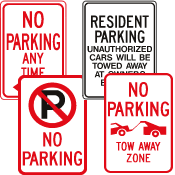Parallel Parking Disaster
June 16, 2010 | in Defensive Driving TipsWe see them all the time. You’re driving through the parking garage looking for a space, when you notice a small hybrid that has been parked at a diagonal, taking up two spaces. Or you’re walking down the street and see a minivan parked two feet away from the curb, so that its left side view mirror is begging to be destroyed. You walk or drive by, smile smugly to yourself, and think: some people can’t park. Or, if you’re more like me, you admit: there but for the grace of God go I.

I am–or rather was–a terrible parker. A crowd of bystanders once gathered to watch me parallel park, all shouting conflicting advice. I used to be so terrified of ANY kind of parking that I would circle around parking lots looking for a row of empty spaces.
This situation went on for an embarrassingly long time (years.) Then, two things happened. First, I moved into a house with the World’s Worst Driveway. This driveway was long and narrow, with high walls on both sides. At the end of the driveway was a small, congested lot, into which we had to cram four cars. Second, I got my first car. It had manual transmission, no power steering, and a very stiff clutch.
The stage was set for a total disaster. However, said disaster never actually occurred. Much to my surprise (and the total bewilderment of friends and family), I actually learned to park. Without scratching my car, destroying other people’s property, or injuring any pedestrians.
My secret is simple. I was patient. When maneuvering my car in and out of parking spaces, I moved very slowly. Very, very slowly. For the first week or two, I asked friends and housemates to direct me out of the driveway. With patience, repetition, and a bit of help, I slowly developed a feel for the car. I figured out how much space my car took up and how to judge the relationship between my car and various obstacles. I learned out how to calculate the angle of approach for various parking-spot entrances and exits.
During eight years of panic and avoidance, I learned very little about parking. After three weeks of patience and regular practice, I was a parking pro and felt confident enough to begin taking advantage of parking spaces others would never dare to attempt, like those small parallel spaces on narrow or heavily trafficked streets. With my newfound skills came perks, like saving money on garage fees, finding city parking at peak hours, and sparing the paint coat on my car. I wish I had learned how to park sooner.
So, if you are a parking-phobe like I was, take heart. A little effort and a lot of patience will go a long way. Don’t let your fear of parking escalate–tackle it today! Here are a few tips to keep in mind as you begin to practice.
PARALLEL PARKING
It’s really not that bad. Parallel parking is, above all, a matter of having a “feel” for your car and how it handles. A week of practice should be more than enough to boost your confidence and skill level.
First, start by finding low-stress situations in which to practice. Try parallel parking in wide spaces on streets with little traffic flow, so that there won’t be pressure to complete the maneuver quickly or dire consequences if you mess up. You may even want to find spaces bordered by only one car; you could also use cones to set up an imaginary parallel parking scenario if you’re particularly concerned about your parking skills. Once you’ve mastered parking in low-stress situations, you can then begin attempting increasingly difficult parking spots, until you’ve built up enough confidence to deal with just about any parallel parking situation.
As for the maneuver itself, the basic idea is simple. You want to maneuver the car in a backwards S in order to slide between two cars and end up parallel to the curb. Use these steps as guidelines for how to proceed:
1. Locate a space that is large enough for your vehicle. Try to size up the space in relation to your car as you drive alongside. If you aren’t fully confident in your ability to fit into the space, move on.
2. Next, use your indicator to signal your intention to park. Then, check your rear and sideview mirrors. If there are cars behind you, make sure that they have stopped far enough back to allow you to complete your maneuver. If not, wait for them to pass you. You may need to wave other drivers forward if they appear confused by your intentions.
3. Now, pull forward to align your car with the car you will park behind. You want to be parallel to this car, about two to three feet away. Your wheels should be aligned with this car’s wheels.
4. Shift your car into reverse, then check your mirrors again. If the coast is clear, turn your wheel far to the right and begin to back into the space. (Note that if you are parking on the left side of the street, either on a one-way street or in a foreign country, these directions should be reversed.)
5. Once the bulk of your car is in the space, turn the wheel to the left, so that your back wheels are pulling you straight back. This will both bring the front end of your car into the space AND make your car parallel with the curb.
6. If your rear wheels hit the curb before you can turn left, simply pull forward a bit before straightening out. Don’t worry if this happens–even experienced parkers make this minor error.
7. Once you’ve got your car into the space, shift back into a forward gear. Turn the wheel to right, and pull forward slowly to center your car in the space.
8. Open your door to check your distance to the curb. You should be no more than 18 inches from the curb. Twelve inches or less is ideal. (Some states do have laws regulating maximum distance from the curb, so check to make sure you know what the legal parameters are for your area.)
If you’ve ended up way too far from the curb or haven’t made it into the space entirely, pull out of the space and return to your original starting position. Then, try again. Be patient with yourself and don’t be embarrassed. Most people struggle with parallel parking, and so are sympathetic to fellow sufferers (I know I am.) Trying to “correct” once you’re in the space is far more difficult and ungainly than starting over–true for most tricky parking situations!
The real trick to parallel parking is getting a feel for your car and how it handles, and for the geometries involved. A British mathematician announced last year that he’d developed a formula for calculating the size of a perfect parking spot. However, given the complexity of the formula, regular practice is probably the easier road to take.
PARKING WITHOUT POWER STEERING
Most parking maneuvers are made more difficult when one is driving a car without power steering. I’ll write more about the trials and joys of driving with various kinds of steering systems in a later entry. For now, my main tip is this: it is easier to turn if your wheels are rolling slightly. Whenever possible, get your car moving, even if it is moving very slowly, before you start to turn. This will also help prevent excess wear and tear on your tires, as “dry turning,” i.e. turning the wheels when at a standstill, is pretty hard on the tires.
PARKING ON A HILL OR INCLINE
Parking on a steep hill can be both tricky and potentially dangerous. If possible, try to park perpendicular to the incline or avoid parking on the hill at all. If you do have to parallel park on a hill, however, there are a few things you should be sure to do.
Be particularly careful when maneuvering into a space on a steep hill. If you’re driving a car with manual transmission, this can be very tricky. However, I’ll deal with hill starts and stops in manual transmission in greater detail in a later entry.
First, put the car in park. In a manual transmission car, leave the car in gear.
Next, apply your parking brake. You should probably do this all the time, even in a car with automatic transmission, as it will prevent potential accidents and reduce tear on the transmission.
Once you’ve done this, turn your wheels. If your car is pointing uphill, turn the steering wheel away from the curb. If you’re pointing downhill, turn the wheel towards the curb. The idea is that, should the car start to roll, the wheels will immediately come into contact with the curb, which will hopefully halt the slip. If not, the car will at least swing out in a direction perpendicular to the hill, rather than sliding straight back and accumulating momentum.
If you’re on a particularly steep hill or you don’t trust your parking break, chock the wheels by wedging a wooden block or stone under the downhill side of one or more of the wheels.
To conclude: don’t be that guy who can’t park! Practice, practice, practice.
To learn more about this topic, or a broad range of subjects from “How To Change A Tire” to “How To Jumpstart Your Car”, visit DefensiveDriving.com’s Safe Driver Resources website!
Check out these sites for more information about online defensive driving in Texas, online defensive driving in Florida, and business driver safety.
← Customer Service | Florida’s 2009 Crash Statistics are now available →


